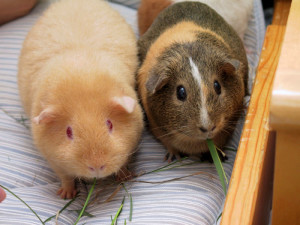
If you are considering guinea pigs as pets, it is important that you understand whether or not a guinea pig is the right pet for you. It very well might not be, and this can be dangerous for the guinea pig, as guinea pigs often have a difficult time finding homes. Many misinformed people think of guinea pigs as nothing more than a special breed of rodents. They associate guinea pigs with hamsters – or worse, rats. In one sense, they are correct. The guinea pig is a member of the rodent family, but it is not a rat. In fact, guinea pigs can be very lovable, and they do make interesting pets. It is important to realize that when you purchase a guinea pig, you are not purchasing a hamster. Hamsters are quite active, and guinea pigs are not – but they do require food, water, a proper enclosure, grooming, veterinarian care, and of course love and attention. The first objective is to make absolutely sure that you are not ‘impulse shopping’ when you buy your guinea pig. You should never buy a guinea pig without doing the proper research, and really discovering whether or not this type of pet will work well for you and your family. Guinea pigs seldom belong to one member of the family. They belong to everybody, and no one person should be solely responsible for their care. If you are purchasing the pet for a child, don’t use these wonderful creatures as ‘learning tools.’ Children do become bored with their pets, and cannot be expected to continue caring for it. Therefore, everyone in the family must be willing to take responsibility. Next, make sure that you have room for the guinea pig. Guinea pig homes need to be a bit roomy. If you don’t have the space, don’t get a guinea pig. You also need to be aware that your guinea pig needs hay, water, pellets, and fresh fruits and vegetables. All of this does cost money, and you need to make sure that you can afford your guinea pigs nutritional needs. Your guinea pig will need to see the veterinarian, and this is another expense that you need to consider. Remember that guinea pigs need time and attention. Without these things, they will become unruly, untrusting, and probably will not live very long lives. If you don’t have the time to care for a guinea pig, don’t get one. Guinea pigs as pets can live as long as ten years, and if for some reason you cannot keep the guinea pig, you probably won’t be able to find him a good home, and he will most likely end up in a shelter, and be put to death. If you doubt that you can devote ten years of your life to your guinea pig, again, don’t get one. Again, the decision to get a guinea pig should not be taken lightly. This is something that you must think about carefully. You must also talk with other family members in the house, and really consider whether or not this is the right pet for your home. Guinea pigs hail from South America. It is believed that the guinea pig evolved from the Cavia Cutleri, also known as the Cavy. Unfortunately, they were used as a source of food in the 16th century, and are actually still used as a food source in some areas of South America. But even as far back as the 16th century, sailors often kept guinea pigs as pets, and they made their way to Europe, and eventually to the United States and other parts of the world. The Cavy became the guinea pig because they often sound like pigs, and they were sold for one guinea. Overtime, guinea pig lovers have performed special and careful breeding in order to produce several exotic breeds of guinea pigs. While these amazing little creatures still cling to their original habits, they have become very curious, and very friendly towards the humans who care for them. Today, there are eight different species of guinea pigs, with only one species commonly being kept as a pet. The eight species include Cavia Porcellus, Cavia Aperea, Cavia Tshudii, Cavia Guianae, Cavia Anolaimae, Cavia Nana, Cavia Fulgida, and Cavia Magna. The species that we commonly keep is pets are the Cavia Porcellus. Female guinea pigs are known as sows, and males are known as boars. The babies that they produce are called pups. Fully grown guinea pigs are about ten inches long, and weight no more than three pounds. They are typically fluffy, although there are hairless breeds as well, which are called skinny pigs. The guinea pig has a rather stout body, considering its small size, but it has no tail. Depending on the breed, guinea pigs come in a wide variety of colors and patterns.